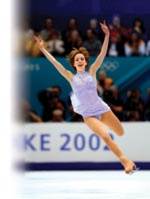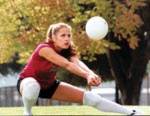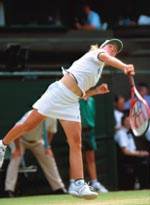WHY WOMEN NEED BFSFasinating new facts and theories about female training open the gates for better, faster, stronger performancesBy Laura Daton Published: Summer 2002 In 1972 when Title IX began to change scholastic sports, coaches and administrators grappled with a new set of problems. Weight rooms with 20-pound-increment stacks, benches and lever positions for athletes 5-foot-10 and over, dumbbells that started from 20 pounds---such facilities were not equipped for these physically weaker and smaller athletes. Then there were the psychological issues---few coaches had any resources when it came to dealing with an athlete who might burst into tears on the playing field. The physical issues were even more complex. Hormonal seesaws that increased and decreased athletic capability were beyond most coaches' expertise. In the past 10 to 15 years things have begun to equalize. The most important equalizer is knowledge. Unfortunately, until recently there has been little scientific data on the female athlete, and we can't inject red dye through their arteries and come up with a quick analysis. Determining the physical and psychological effects of exercise on the human body takes decades. And men have a few thousand years' jump on women in that regard. The bright side is our research techniques have made quantum leaps, allowing us to deduce some facts---and make some educated guesses---about how girls react to exercise. All the answers aren't in, but there are some fascinating new developments. Women May Benefit More Than Men Females carry more fat and store it more efficiently than men, making it harder for them to maintain a lean, athletic body. By increasing muscle mass and stimulating the release of natural biochemicals such as growth hormone, BFS training will raise a woman's metabolism and help her burn fat and stay lean, perhaps even more effectively than aerobics. Another important fact is that even without formal weight training, men tend to perform more manual labor than women. Who climbs the tree to do the trimming, pulls down the broken fence, and wheelbarrows in the new sod? Sure, women chip in with the chores, but much of the backbreaking stuff goes to the men. I tried to jackhammer some six-inch-thick cement we were pulling from our side yard---I lasted about eight seconds! Of course, everyone knows the pickle jar syndrome---after three tries we hand it over to the guy and don't even bother mustering the strength for that last effort that would most likely succeed. Women have also avoided weights because of the ill-fated sport of women's bodybuilding, which produced hundreds of Hulk-like females in the 1980s and still churns out a handful of new exhibitionists a year. Many females and most coaches are now aware that the average woman cannot gain huge muscle without the assistance of muscle building drugs. Today's female athletes use weight training to improve performance, not to build bulky physiques. The end result is that until the last few years, most women entered sports in their early to mid-teens with very little experience. Many middle-aged women are just beginning weight training with no experience, and very little muscle mass left. Between the ages of 30 and 40 women begin to lose muscle at a relatively fast pace. Remember the lady who says, "I've fallen---and I can't get up!" Twice as many women fall and break their hips as men do. Balance deteriorates, bones become brittle and the additional fat (from the lowering of the metabolism) compounds their health problems. The loss of muscle does not have to be an inevitable part of aging. Using your muscles, especially the fast-twitch muscles recruited in a BFS program, is one of the best ways to help keep the aging process at bay. Another huge benefit for women who weight train is the positive effect on bone density---weight-bearing exercises can actually help reverse osteoporosis. It also has a positive effect on cardiovascular fitness and mental health. It's a medical fact that depression affects more women than men, and strength training has been proven to decrease depression and anger. Even sufferers of arthritis benefit from weight training! Many of these conditions occur after age 40, so you may be wondering what this has to do with today's up-and-coming athletes. Lots. Young girls are rarely encouraged to flex their muscles. They don't get involved in sports as early as boys, and because of these factors they have little experience with fast-twitch muscle training such as BFS. They tend to be slow starters and may need an attitude change regarding the appropriateness of grunting during a BFS lift. The earlier they begin, the easier it will be to maintain this type of training for a lifetime, which truly will help them to maintain quality in their health and longevity. As for vanity, they will also look far more trim and vibrant than women who have never set foot in the weight room. How Fast Can a Woman Go? Michael Yessis is a conditioning consultant in Escondido, California, who has worked with many professional athletes. In the November, 2000 issue of Scientific American Presents, Yessis was quoted in an article by Bruce Schechter that "genetics only determines about one-third of an athlete's capabilities. But with the right training we can go much further with that one-third than we've been going." Fast-twitch muscle development may have tremendous health benefits for the female, but that alone will not provide her with medal-winning records. BFS trains athletes for sports, which is why the program includes such athletic training methods as plyometrics. "When a sprinter runs," Yessis explains, "her foot stays in contact with the ground for only a little under a tenth of a second, half of which is devoted to landings and the other half to pushing off. Plyometric exercises help athletes make the best use of this brief interval." In volleyball, basketball and soccer, it's been estimated that women can be as much as eight times more likely than men to injure the anterior cruciate ligament, or ACL, which helps stabilize the knee. According to the American Orthopedic Society for Sports Medicine, each year approximately 20,000 high school girls suffer serious knee injuries, most involving the ACL. Several theories have been proposed to determine why women are at such a high risk; here are just a few: • Girls don't usually get involved in sports at a young age, leaving their coordination for sports behind that of males. • Because women have less muscle mass than men, they may rely more on their ligaments for support than on their muscles. • A woman's wider pelvis changes the alignment of her lower extremities, causing a woman's thighs to angle inward in a knock-kneed position and the lower legs and feet to turn outwards, putting the lower extremities in a vulnerable position. The BFS program specifically develops one of the most important muscle groups in preventing ACL injuries: the hamstrings. Researchers have determined that the deadlift and the power clean are great exercises that work the hamstrings, but for direct work you can't beat the glute-ham raise. A BFS auxiliary lift, the glute-ham raise enables the athlete to work both the knee and hip extensor functions of the hamstrings, unlike the leg curl which only works knee extension or the back extension which only works hip extension. Men have been breaking their own records for centuries. It was once believed that breaking the four-minute mile was impossible. Not only was it achieved, but with each passing year the times became faster. Today, the limits to females' performance are not even in sight. Pain and Flexibility Differences Studies have shown that women are more apt to report symptoms of injury than men. Research conducted at the Neurology Research Laboratory at the University of Michigan, Ann Arbor, shows that the forebrains of women subjects were significantly more active during pain than men's. With the same level of stimulus to the forearm, women reported more pain than men did. |
 |
|
Gold Medalist Sarah HUges |
 |
|
Stanford's Logan Tom |
 |
|
Weight training is an important part of stanford University's Logan Tom training for volleyball. An Olympian who is originally from Salt Lake City, Utah, Logan is considered the best collegiate player in the country. |
 |
|
Sarah Huges shocked the world when she won the Olympic gold medal in Salt Lake City, Utah. Her next goal is to score 1500 on the SAT. |
 |
|
Although she is onlt 18 years old, Kim Clijsters of Bilzen, Belgium is ranked 4th in the world by the Women's Tennis Association (WTA) |
 |
|
Over the past two years Justine Henin of Liege, Belgium, has suffered from wrist, arm, toe, ankle and foot injures. Nevertheless, she is ranked 8th in the world and last year reached the finals of Wimbledon. |